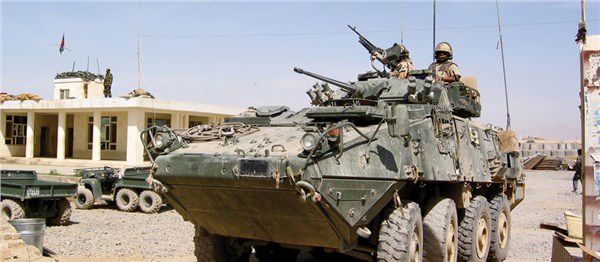Canadian Trial: An Israeli Merkava Mk4 tank equipped with the Trophy active protection system. The system will be tested on a Canadian light armored vehicle this month. (Israel Defense Forces)
Oct. 15, 2013 - By BARBARA OPALL-ROME and DAVID PUGLIESE - Defense News
GDLS Integrates Rafael's Trophy on Troop Carrier
TEL AVIV AND VICTORIA, BRITISH COLUMBIA — General Dynamics Land Systems (GDLS) and its Canadian subsidiary are hosting a mid-October demonstration of what the firm is billing as “the first North American combat vehicle with a fully integrated Active Protection System (APS).”
The live-fire event for Canadian Army officers and defense procurement officials will test a Canadian Army light armored vehicle III equipped with a version of the Israeli-developed Trophy APS against rocket-propelled grenades (RPGs), defense and industry sources said.
Deployed in August 2009, Trophy is designed to neutralize all types of chemical energy threats in flight, from rocket-propelled grenades to high-explosive rounds and tandem warhead anti-tank guided missiles.
The demo, planned for this month at a Canadian test range, follows a series of tests concluded last month on the GDLS-integrated vehicle protected by a version of Trophy, a system developed by Israel’s state-owned Rafael and used on Merkava Mk4 main battle tanks, the sources said.
The event will coincide with the Aerospace Industries Association of Canada’s annual conference and precedes the annual exposition of the Association of the US Army scheduled for Oct. 21-23 in Washington.
Rafael executives would not comment on the upcoming test, referring all queries to GDLS. Ken Yamashita, corporate affairs manager for London, Ontario-based GDLS Canada, declined comment on a matter he considered “classified or sensitive.”
In a May 29 press release, Sterling Heights, Mich.-based GDLS announced it was leading an effort to develop “the first North American combat vehicle with a fully integrated Active Protection System.”
At the time, the company did not identify Rafael as its partner but noted that GDLS aimed to “demonstrate APS technology readiness and integration efficiencies, and reduce the time it takes to bring this lifesaving survivability technology to customers.”
Eyeing Future Buys
Successful tests of the GDLS-integrated vehicle are expected to boost its standing against BAE Systems for the US Army’s Ground Combat Vehicle (GCV), a prospective multibillion-dollar program for a future infantry fighting vehicle.
The US Army’s GCV program office released a request for information this month for combined active protection and hostile fire detection capabilities “that could potentially be applied to tactical and combat ground vehicles.”
Company responses, due Nov. 1, are likely to influence formal Army requirements if and when the service is authorized to select one of the two firms to proceed into full-scale GCV development.
In parallel, the Canadian Army is planning its own competition for APS-equipped ground vehicles.
In an Oct. 3 meeting in London, Ontario, Canadian Army Col. Andrew Jayne briefed industry representatives on future equipment programs, including plans to buy limited quantities of an APS to protect the service’s “highest value assets,” he said.
Canada’s interest in APS capabilities dates to 2006, when it asked industry for a system that could provide all-around protection of light armored vehicles capable of defeating projectiles launched from a minimum distance of 15 meters to 25 meters, as well as threats launched from greater distances.
At the time, Yigal Ben-Hanan, president of Rafael USA, said the Israeli firm had teamed with GDLS-Canada to offer a Trophy-based system for the Canadian Army.
Revised Canadian military modernization plans have drastically delayed APS procurement, with orders for actively protected vehicles now scheduled for 2023-27, according to a copy of Jayne’s presentation obtained by Defense News.
Integration of Trophy on the GDLS-produced LAV III is co-funded by GDLS and Rafael and is aimed at “trying to help customers understand the benefits and burdens” of a fully integrated APS-defended vehicle, a former government official said.
While the Trophy-equipped platform represents a “reputable solution” to emerging needs for mobility and force protection, the former official said he believed it does not wed GDLS to a particular vehicle or to the Rafael system.
An Israeli defense source noted that Rafael’s Trophy remains the world’s only operationally proven active protection solution, which continues to enjoy full support by Israel’s Ministry of Defense.
The Trophy was first activated during a March 2011 Israeli operation in Gaza, when a Merkava Mk4 tank equipped with the system destroyed an RPG-29 fired from Gaza with no damage to the protected tank or its four-man crew.
It scored another operational intercept in August 2012 against an anti-tank missile fired at an Mk4 tank near a crossing point in central Gaza. Since then, Israeli military sources cite several other events along its northern and southern borders in which the system detected and classified threats.
According to Rafael marketing data, Trophy offers 360-degree protection against multiple launches “while maintaining a pre-defined safety zone for friendly dismounted troops.”
The operational Trophy-HV (for heavy vehicles exceeding 30 tons) and the prototype Trophy-MV (for medium vehicles exceeding 15 tons) use hard-kill countermeasures that “literally beheads the rocket before it has a chance to initiate or make impact,” according to Rafael data.
The firm’s newest, downsized Trophy-LV (for light vehicles less than eight tons) uses what the firm described as “energetic blades” to neutralize RPGs launched at very short range, providing similar 360-degree protection as the larger variants “at a fraction of the weight and cost,” according to Rafael.
A senior Rafael executive said developmental testing of its Trophy-LV integrated on a Humvee is complete and program officials are ready to integrate the system on other platforms according to customer needs.
“We’re applying the vast operational experience of Trophy-HV into increasingly capable, cost-effective versions for medium and light vehicles,” the executive said. “We’re convinced that the need for actively defended vehicles will increase dramatically.”
He added, “When decision-makers are convinced such a solution exists, it will be hard to explain why their forces are coming home in body bags.”













